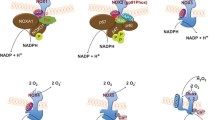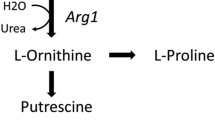Abstract
Arginase is a manganese metalloenzyme that regulates the intracellular availability of L-arginine through its hydrolysis to urea and L-ornithine. Arginine is a common substrate for both nitric oxide synthase (NOS) and arginase. L-Arginine converted to nitric oxide (NO) and L-ornithine by nitric oxide synthase. Nitric oxide (NO) initiates the immunomodulatory effects within host and imparts defense by inducing microbicidal activity against invading pathogens within the cellular microenvironment. Therefore, the competition between arginase and nitric oxide synthase for arginine plays a determinant role in immune response against microbial pathogenesis. It was reported that depletion of arginine by myeloid cells expressing arginase 1 leads to suppression of T-cell immune response. Pathogens themselves were found to synthesize arginase to escape host immune response. Recent research has identified that reactive oxygen species (ROS) plays a significant role in the regulation of arginase activity and expression during microbial infection. Pathogen survival within the host system depends on the inclination to arginase pathway. Moreover, arginase participates in arginine metabolism which provides an essential route for sustainability of pathogen survival and reproduction within the host by negotiating host defense response. Researchers currently have shown that arginase modulates the host immune response and infection pathology in many ways during microbial, parasitic, and also viral infections. In this chapter, we have discussed about the involvement of arginase in the modulation of NO during inflammatory response coined by host upon encounter to pathogen. We have highlighted the involvement of arginase in the modulation of host immune response during bacterial, viral, and parasitic infection. The current and potential therapeutic approaches against microbial diseases by targeting arginase function were discussed.
Access this chapter
Tax calculation will be finalised at checkout
Purchases are for personal use only
Similar content being viewed by others
References
Romagnoli G, Verhoeven MD, Mans R et al (2014) An alternative, arginase-independent pathway for arginine metabolism in Kluyveromyces lactis involves guanidinobutyrase as a key enzyme. Mol Microbiol 93(2):369–389
Mielczarek-Puta M, Chrzanowska A, Barańczyk-Kuźma A (2008) New insights into arginase. Part I. Structure and characteristics. Postepy Hig Med Dosw (Online) 62:206–213
Jenkinson CP, Grody WW, Cederbaum SD (1996) Comparative properties of arginases. Comp Biochem Physiol B Biochem Mol Biol 114(1):107–132
Caldwell RB, Toque HA, Narayanan SP et al (2015) Arginase: an old enzyme with new tricks. Trends Pharmacol Sci 36(6):395–405
Caldwell RW, Rodriguez PC, Toque HA et al (2018) Arginase: a multifaceted enzyme important in health and disease. Physiol Rev 98(2):641–665
Das P, Lahiri A, Lahiri A et al (2010) Modulation of the arginase pathway in the context of microbial pathogenesis: a metabolic enzyme moonlighting as an immune modulator. PLoS Pathog 6(6):e1000899
Chandra S, Romero MJ, Shatanawi A et al (2012) Oxidative species increase arginase activity in endothelial cells through the RhoA/Rho kinase pathway. Br J Pharmacol 165:506–519
Gao X, Xu X, Belmadani S et al (2007) TNF-alpha contributes to endothelial dysfunction by upregulating arginase in ischemia/reperfusion injury. Arterioscler Thromb Vasc Biol 27:1269–1275
Pandey D, Bhunia A, Oh YJ et al (2014) OxLDL triggers retrograde translocation of arginase2 in aortic endothelial cells via ROCK and mitochondrial processing peptidase. Circ Res 115:450–459
Wang L, Bhatta A, Toque HA et al (2015) Arginase inhibition enhances angiogenesis in endothelial cells exposed to hypoxia. Microvasc Res 98(1–8):2015
Shatanawi A, Lemtalsi T, Yao L et al (2015) Angiotensin II limits NO production by upregulating arginase through a p38 MAPK-ATF-2 pathway. Eur J Pharmacol 746:106–114
Sheldon KE, Shandilya H, Kepka-Lenhart D et al (2013) Shaping the murine macrophage phenotype: IL-4 and cyclic AMP synergistically activate the arginase I promoter. J Immunol 191:2290–2298
Morris SM (2007) Arginine metabolism: boundaries of our knowledge. J Nutr 137(6):1602S–1609S
Morris S Jr (2002) Regulation of enzymes of the urea cycle and arginine metabolism. Annu Rev Nutr 22:87–105. https://doi.org/10.1146/annurev.nutr.22.110801.140547
Förstermann U, Sessa WC (2011) Nitric oxide synthases: regulation and function. Eur Heart J 33(7):829–837, 837a–837d
Xue Q, Yan Y, Zhang R et al (2018) Regulation of iNOS on immune cells and its role in diseases. Int J Mol Sci 19(12):3805
Wu G, Morris SM Jr (1998) Arginine metabolism: nitric oxide and beyond. Biochem J 336(Pt1):1–17
Maarsingh H, Zaagsma J, Meurs H (2009) Arginase: a key enzyme in the pathophysiology of allergic asthma opening novel therapeutic perspectives. Br J Pharmacol 158(3):652–664
Rath M, Müller I, Kropf P et al (2014) Metabolism via arginase or nitric oxide synthase: two competing arginine pathways in macrophages. Front Immunol 5:532
Yang Z, Ming XF (2014) Functions of arginase isoforms in macrophage inflammatory responses: impact on cardiovascular diseases and metabolic disorders. Front Immunol 5:533
Rodriguez PC, Ochoa AC, Al-Khami AA (2017) Arginine metabolism in myeloid cells shapes innate and adaptive immunity. Front Immunol 8:93
Stunault MI, Bories G, Guinamard RR et al (2018) Metabolism plays a key role during macrophage activation. Mediat Inflamm 2018:Article ID 2426138, 10 pages
Barron L, Wynn TA (2011) Macrophage activation governs schistosomiasis-induced inflammation and fibrosis. Eur J Immunol 41(9):2509–2514
Pesce JT, Ramalingam TR, Mentink-Kane MM et al (2009) Arginase-1-expressing macrophages suppress Th2 cytokine-driven inflammation and fibrosis. PLoS Pathog 5(4):e1000371
Hesse M, Modolell M, La Flamme AC et al (2001) Differential regulation of nitric oxide synthase-2 and arginase-1 by type 1/type 2 cytokines in vivo: granulomatous pathology is shaped by the pattern of L-arginine metabolism. J Immunol 67(11):6533–6544
Vogiatzi P, Cassone M, Luzzi I et al (2007) Helicobacter pylori as a class I carcinogen: physiopathology and management strategies. J Cell Biochem 102:264–273
McGee DJ, Radcliff FJ, Mendz GL et al (1999) Helicobacter pylori rocF is required for arginase activity and acid protection in vitro but is not essential for colonization of mice or for urease activity. J Bacteriol 181:7314–7322
Gobert AP, McGee DJ, Akhtar M et al (2001) Helicobacter pylori arginase inhibits nitric oxide production by eukaryotic cells: a strategy for bacterial survival. Proc Natl Acad Sci U S A 98:13844–13849
Chaturvedi R, Asim M, Lewis ND et al (2007) L arginine availability regulates inducible nitric oxide synthase-dependent host defense against helicobacter pylori. Infect Immun 75:4305–4315
Zabaleta J, McGee DJ, Zea AH et al (2004) Helicobacter pylori arginase inhibits T cell proliferation and reduces the expression of the TCR zeta-chain (CD3zeta). J Immunol 173:586–593
Gobert AP, Cheng Y, Wang JY et al (2002) Helicobacter pylori induces macrophage apoptosis by activation of arginase II. J Immunol 168:4692–4700
Bussiere FI, Chaturvedi R, Cheng Y et al (2005) Spermine causes loss of innate immune response to Helicobacter pylori by inhibition of inducible nitric-oxide synthase translation. J Biol Chem 280:2409–2412
Yamada KJ, Heim CE, Aldrich AL et al (2018) Arginase-1 expression in myeloid cells regulates Staphylococcus aureus planktonic but not biofilm infection. Infect Immun 86(7):pii:e00206-18
Duque-Correa MA, Kühl AA, Rodriguez PC et al (2014) Macrophage arginase-1 controls bacterial growth and pathology in hypoxic tuberculosis granulomas. Proc Natl Acad Sci U S A 111(38):E4024–E4032
Qualls JE, Neale G, Smith AM et al (2010) Arginine usage in mycobacteria-infected macrophages depends on autocrine-paracrine cytokine signaling. Sci Signal 3(135):ra62
Jamaati H, Mortaz E, Pajouhi Z (2017) Nitric oxide in the pathogenesis and treatment of tuberculosis. Front Microbiol 8:2008
Ruby T, McLaughlin L, Gopinath S et al (2012) Salmonella’s long-term relationship with its host. FEMS Microbiol Rev 36(3):600–615
Das P, Lahiri A, Lahiri A et al (2010) Cationic amino acid transporters and Salmonella Typhimurium ArgT collectively regulate arginine availability towards intracellular Salmonella growth. PLoS One 5(12):e15466
Knippenberg S, Brumshagen C, Aschenbrenner F et al (2015) Arginase 1 activity worsens lung-protective immunity against Streptococcus pneumoniae infection. Eur J Immunol 45(6):1716–1726
Mehl A, Ghorbani P, Douda D (2014) Effect of arginase inhibition on pulmonary L-arginine metabolism in murine Pseudomonas pneumonia. PLoS One 9(3):e90232
Takele Y, Abebe T, Weldegebreal T et al (2013) Arginase activity in the blood of patients with visceral leishmaniasis and HIV infection. PLoS Negl Trop Dis 7(1):e1977
Cloke TE, Garvey L, Choi BS et al (2010) Increased level of Arginase activity correlates with disease severity in HIV-seropositive patients. J Infect Dis 202(3):374–385
Cao W, Sun B, Feitelson MA et al (2009) Hepatitis C virus targets over-expression of arginase I in hepatocarcinogenesis. Int J Cancer 124(12):2886–2892
Felizardo AA, Caldas IS, Mendonça AAS (2018) Impact of Trypanosoma cruzi infection on nitric oxide synthase and arginase expression and activity in young and elderly mice. Free Radic Biol Med 129:227–236
Aoki MP, Guiñazú NL, Pellegrini AV (2004) Cruzipain, a major Trypanosoma cruzi antigen, promotes arginase-2 expression and survival of neonatal mouse cardiomyocytes. Am J Physiol Cell Physiol 286(2):C206–C212
Balaña-Fouce R, Calvo-Álvarez E, Álvarez-Velilla R et al (2012) Role of trypanosomatid’s arginase in polyamine biosynthesis and pathogenesis. Mol Biochem Parasitol 181(2):85–93
Chang CI, Zoghi B, Liao JC et al (2000) The involvement of tyrosine kinases, cyclic AMP/protein kinase A, and p38 mitogen-activated protein kinase in IL-13-mediated Arginase I induction in macrophages: its implications in IL-13-inhibited nitric oxide production. J Immunol 165:2134–2141
Atri C, Guerfali FZ, Laouini D (2018) Role of human macrophage polarization in inflammation during infectious diseases. Int J Mol Sci 19(6):pii:E1801
Rodrigues JPF, Caldas IS, Gonçalves RV (2017) S. mansoni-T. cruzi co-infection modulates arginase-1/iNOS expression, liver and heart disease in mice. Nitric Oxide 66:43–52
Achkar JM, Fries BC (2010) Candida infections of the genitourinary tract. Clin Microbiol Rev 23(2):253–273
Ghosh S, Navarathna DH, Roberts DD et al (2009) Arginine-induced germ tube formation in Candida albicans is essential for escape from murine macrophage line RAW 264.7. Infect Immun 77:1596–1605
Mogensen E, Mühlschlegel FA (2008) CO2 sensing and virulence of Candida albicans. In: Brakhage AA, Zipfel PF (eds) Human and animal relationships. The Mycota (A comprehensive treatise on fungi as experimental systems for basic and applied research), vol 6. Springer, Berlin/Heidelberg
Mock RC, Pollack JH, Hashimoto T (1990) Carbon dioxide induces endotrophic germ tube formation in Candida albicans. Can J Microbiol 36(4):249–253
Heby O, Persson L, Rentala M (2007) Targeting the polyamine biosynthetic enzymes: a promising approach to therapy of African sleeping sickness, Chagas’ disease, and leishmaniasis. Amino Acids 33:359–366
Bansal V, Ochoa JB (2003) Arginine availability, arginase, and the immune response. Curr Opin Clin Nutr Metab Care 6:223–228
Ng KP, Manjeri A, Lee LM (2018) The arginase inhibitor Nω-hydroxy-nor-arginine (nor-NOHA) induces apoptosis in leukemic cells specifically under hypoxic conditions but CRISPR/Cas9 excludes arginase 2 (ARG2) as the functional target. PLoS One 13(10):e0205254
Wang CC (1991) A novel suicide inhibitor strategy for antiparasitic drug development. J Cell Biochem 45:49–53
Gonzalez NS, Huber A, Algranati ID (2001) Spermidine is essential for normal proliferation of trypanosomatid protozoa. FEBS Lett 508:323–326
Klasen S, Hammermann R, Fuhrmann METAL (2001) Glucocorticoids inhibit lipopolysaccharide-induced up-regulation of arginase in rat alveolar macrophages. Br J Pharmacol 132(6):1349–1357
Acknowledgments
The author acknowledges the support of Ms. Trishna Mahanty and Dr. Avik Sarkar in the preparation of the manuscript. Indian government extramural research funds from Indian Council of Medical Research and SERB-Department of Science and Technology to author’s laboratory are sincerely acknowledged.
Author information
Authors and Affiliations
Corresponding author
Editor information
Editors and Affiliations
Rights and permissions
Copyright information
© 2019 Springer Nature Singapore Pte Ltd.
About this chapter
Cite this chapter
Bhattacharjee, S. (2019). Arginase: A Prospective Regulator of Oxidative Stress During Microbial Pathogenesis. In: Chakraborti, S., Chakraborti, T., Chattopadhyay, D., Shaha, C. (eds) Oxidative Stress in Microbial Diseases. Springer, Singapore. https://doi.org/10.1007/978-981-13-8763-0_6
Download citation
DOI: https://doi.org/10.1007/978-981-13-8763-0_6
Published:
Publisher Name: Springer, Singapore
Print ISBN: 978-981-13-8762-3
Online ISBN: 978-981-13-8763-0
eBook Packages: Biomedical and Life SciencesBiomedical and Life Sciences (R0)




